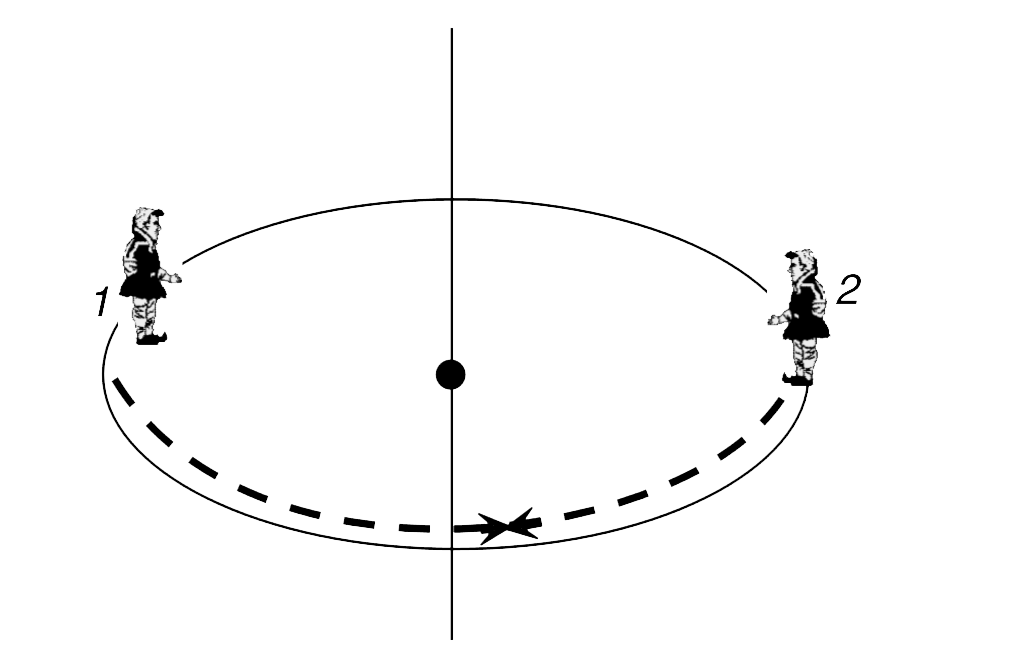A buggy of mass 100 kg is free to move on a frictionless horizontal track. Two men, each of mass 50 kg, are standing on the buggy, which is initially stationary. The men jump off the buggy with velocity =10m/s relative to the buggy. In one situation, the men jump one after the other. in another situation, the men jump simultaneously. what is the ratio of the velocities of the buggy in two cases?
The correct Answer is:C
Step by step video, text & image solution for A buggy of mass 100 kg is free to move on a frictionless horizontal track. Two men, each of mass 50 kg, are standing on the buggy, which is initially stationary. The men jump off the buggy with velocity =10m/s relative to the buggy. In one situation, the men jump one after the other. in another situation, the men jump simultaneously. what is the ratio of the velocities of the buggy in two cases? by Physics experts to help you in doubts & scoring excellent marks in Class 11 exams.
Topper's Solved these Questions
- BOOK - ANURAG MISHRACHAPTER - IMPULSE AND MOMENTUMEXERCISE - L-221videos
IMPULSE AND MOMENTUM
- BOOK - ANURAG MISHRACHAPTER - IMPULSE AND MOMENTUMEXERCISE - L-3,(P-1)5videos
IMPULSE AND MOMENTUM
- BOOK - ANURAG MISHRACHAPTER - IMPULSE AND MOMENTUMEXERCISE - Example50videos
IMPULSE AND MOMENTUM
- BOOK - ANURAG MISHRACHAPTER - FORCE ANALYSISEXERCISE - Matching type13videos
FORCE ANALYSIS
- BOOK - ANURAG MISHRACHAPTER - RIGID BODY MOTIONEXERCISE - MATCH THE COLUMN12videos
RIGID BODY MOTION
Similar Questions
Knowledge Check
- Question 1 - Select One
Two identical buggies of each of mass 150kg move one after the other friction with same velocity 4m/s. A man of mass m rides the rear buggy. At a certain moment, the man jumps into the front buggy with a velocity v relative to his buggy. As a result of this process, real boggy stops. If the sum of kinetic energies of the man and the front buggy just after collision with the from buggy differs from that just before collision by 2700J then
The velocity v of the man relartive to the buggy isA16m/sB8m/sC10m/sD15m/s - Question 2 - Select One
Two identical buggies of each of mass 150kg move one after the other friction with same velocity 4ms. A man of mass m rides the rear buggy. At a certain moment, the man jumps into the front buggy with a velocity v relative to his buggy. As a result of this process, real boggy stops. If the sum of kinetic energies of the man and the front buggy just after collision with the from buggy differs from that just before collision by 2700J then
the mass m of the man isA60kgB75kgC50kgD90kg - Question 3 - Select One
5 men each of mass 100 kg are travelling in different cars as shown. Choose the correct alternative(s)
 Apseudo force on A as seen by B will be 500NBpseudo force on C as seen by B will be 500√2N.Cpseudo force on D as seen by B will be 1000NDpseudo force on B as seen by E will be 1000N
Apseudo force on A as seen by B will be 500NBpseudo force on C as seen by B will be 500√2N.Cpseudo force on D as seen by B will be 1000NDpseudo force on B as seen by E will be 1000N
Two men, each of mass m, stand on the edge of a stationary buggy of mass M. Assuming the friction to be negligible, find the velocity of the buggy after both men jump off with the same horizontal velocity u relative to the buggy: (1) simultaneously, (2) one after the other. In what case will the velocity of the buggy be greater and how many times?
View SolutionA trolley of mass M is at rest over a smooth horizontal surface as shown in figure. Two boys each of mass 'm' are standing over the trolley. They jump from the trolley (towards right) with relative velocity vr [relative to velocity of trolley just after jumping]
(a) together
(b) one after the other.
Find velocity of trolley in both cases.
 View Solution
View SolutionA (trolley + child) of total mass 200 kg is moving with a uniform speed of 36 km/h on a frictionless track. The child of mass 20 kg starts running on the trolley from one end to the other (10 m away) with a speed of 10 ms–1 relative to the trolley in the direction of the trolley's motion and jumps out of the trolley with the same relative velocity. What is the final speed of the trolley? How much has the trolley moved from the time the child begins to run?
View SolutionA horizontal turn table of mass 90kg is free to rotate about a vertical axis passing through its centre. Two men –1 and 2 of mass 50kg and 60kg respectively are standing at diametrically opposite point on the table. The two men start moving towards each other with same speed (relative to the table) along the circumference. Find the angle rotated by table by the time the two men meet. Treat the men as point masses.
 View Solution
View SolutionA trolly of mass 200kg moves with a uniform speed of 36 km/h on a frictionless track. A child of mass 20kg runs on the trolly from one end to the other (10m away) with a speed of 4m/s relative to the trolly in a direction opposite to the trolly's motion and jumps out of the trolly. How much has teh trolly moved from the time the child begins to run ?
View Solution

